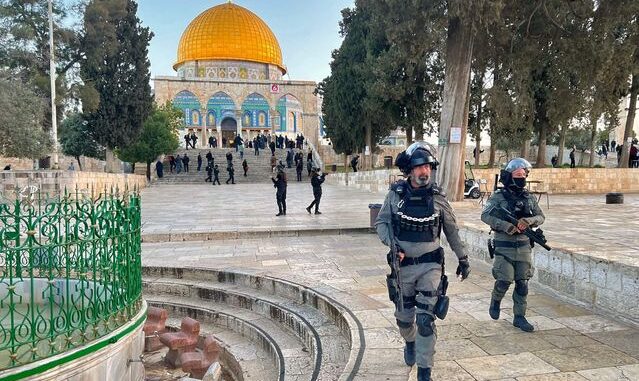The Iranian proxies ramp up their attacks on the Jewish state.

Israeli police walk inside the Al-Aqsa mosque compound in Jerusalem, April 5.
A sequence of dramatic events over the past three days has brought Israel to the brink of war with Iran-backed militias in Southern Lebanon and the Gaza Strip. This is the product of a continuing effort by Tehran and its various franchises to “unite the arenas” of engagement with the Jewish state against the background of the Muslim holy month of Ramadan. It isn’t yet clear if Israel has developed a coherent strategy to counter this Iranian effort.
Tehran and its Islamic Revolutionary Guard Corps control several military and political assets in the region. The Lebanese Hezbollah organization, the oldest and most powerful of the IRGC’s regional franchises, is the de facto ruling power in Lebanon. Hamas, which rules the Gaza Strip, depends on the IRGC for its military capacities and possesses an extensive political and notable military infrastructure in the West Bank and, it seems, also in southern Lebanon.
Lesser pieces on the board include Palestinian Islamic Jihad, which is a fully owned IRGC franchise, and smaller paramilitary bodies. Other elements among the religious activists currently seeking to inflame the situation on the Temple Mount/Al Aqsa Compound could be linked to this or that organization, but most likely they answer to Hamas.
It’s been clear for a while that something is brewing. On March 13 a heavily armed man entered Israel from Lebanon and planted an explosive device at a busy intersection near Megiddo. Israeli special forces tracked the operative, killing him as he tried to slip back across the border. Nothing of this sort could have happened without Hezbollah’s knowledge, permission and approval.
Hezbollah-associated media have made no secret of the axis’ intentions. Ibrahim al-Amin, an associate of Hezbollah leader Hassan Nasrallah and editor of the Al-Akhbar newspaper in Beirut, wrote in a March 20 editorial that ‘‘the coming month of Ramadan will be an occasion to announce a new, more effective level of coordination between the resistance forces in the entire region.” He went on to note the goal of the “unity of the arenas . . . the aim of which is to raise resistance activity inside Palestine to a level that opens the door to a comprehensive uprising.”
The “resistance,” he concluded “realizes that direct, qualitative action on the entire area of historical Palestine represents the starting point for the complete liberation project.”
The events of the past 72 hours follow al-Amin’s script. Agitation by Islamist activists of unclear loyalties led to an inevitable crackdown on the Temple Mount/Al Aqsa Compound by Israeli security forces, including some 350 arrests. The activists had sought to stay overnight in the mosque in violation of an agreement between the Israeli authorities and the Islamic waqf that administers the area. This practice, known as itikaf, is allowed at the site only during the last 10 days of Ramadan. The crackdown was followed on Wednesday by a fusillade of rockets launched at Israel from Hamas-controlled Gaza. Al-Quds Brigade, Islamic Jihad’s military wing, claimed responsibility. Israel responded by hitting targets in the Gaza Strip with airstrikes.
On Thursday, militants in Hezbollah-controlled Southern Lebanon launched a salvo of 34 rockets at targets in northern Israel. Israel then struck targets it said were associated with Hamas in Southern Lebanon. With tensions still high, Palestinian terrorists shot two young Israeli women in an execution-style killing in the Jordan Valley near Hamra on Friday.
The larger player shields the smaller. In Hamas-controlled Gaza, the smaller Islamic Jihad fires the rockets, presumably calculating that Israel wishes to avoid major air or ground action in Gaza and hence will prefer not to strike back, or to strike only in a limited way. In Hezbollah-controlled Lebanon, meanwhile, Hamas is tasked with the rocket fire. This division of labor enables limited Israeli response against Hamas only.
The planners on the pro-Iran side calculate that Israel wishes to avoid tangling with Hezbollah and a descent to open war. So they assume that the smaller partner can act with impunity, then nestle under the wing of its larger ally.
So far, Israel appears to have obliged. Its military has studiously avoided Hezbollah targets in Lebanon, although no one thinks Hamas chose to launch 34 rockets from Lebanon without Hezbollah’s permission.
There is a danger to Israel in letting these unspoken rules become entrenched. The pro-Iran axis is clearly feeling confident. This derives from a sense of U.S. withdrawal from the region and government dysfunction in Israel. The rise in Palestinian militancy on the West Bank since the beginning of the year, and the annual rise in pressure around the Ramadan period, further contribute to the sense of opportunity in this camp.
If Israel continues to avoid escalation to war, it may eventually find that its deterrence erodes to the point that it can no longer guarantee Israelis normal lives. The desire for normalcy pursued at too high a cost ends up forfeiting the very thing it seeks. Israel should as a matter of urgency pursue the goal of restoring the eroded balance of terror that had largely held since 2006—even if this entails hitting the senior and junior members of the Iran-led regional axis.
Mr. Spyer is director of research at the Middle East Forum and director of the Middle East Center for Reporting and Analysis. He is author of “Days of the Fall: A Reporter’s Journey in the Syria and Iraq Wars.”



Day of Judgement: Mordechai Keidar Warns That Major Iranian Attack Is Coming
Here is the original article by Keidar:
https://www.makorrishon.co.il/opinion/602385/